The Samurai, The Ship And The Golden Gate
By Romulus Hillsborough
In January 1860, the Tokugawa Shogunate, the feudal military
government which ruled Japan for over two and a half centuries, dispatched
an official delegation to Washington to ratify the first commercial treaty
between Japan and the United States.
| |
Japanese mission members including Katsu Kaishu,
Fukuzawa Yukishi and Jehn Manjior. The San Francisco “Evening
Bulletin described the arriving Samurai (officers) on March 19,
1860, as “wearing polished samurai swords, two each. Every
man’s hair was got up without regard to expense, lavishly
greased…and carefully dressed. Their dress bears some resemblance
to that of the richer Chinese, but exhibits a taste of more harmony
with our own.” There were… “innumerable servants,
who with bowed head, received orders and answered questions for
their superiors.” |
The members of the delegation sailed aboard a U.S. Navy steam frigate.
In advance of the delegation, the shogunate sent the tiny schooner Kanrin
Maru. In command of the Kanrin Maru was a fascinating man by the name
of Katsu Kaishu – an expert swordsman who refused to draw his sword,
founder of the Japanese Navy, and one of the most revered personages in
Japanese history. Accompanying Captain Katsu and Company was U.S. Navy
Lieutenant John M. Brooke, who criticized the Japanese for their lack
of maritime expertise.
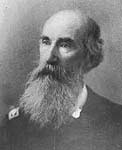 U.S.
Navy Lieutenant John M. Brooke, who criticized the Japanese for
their lack of maritime expertise. Interestingly, in April 1861 with
the succession crisis deepening, Brooke resigned his commission
and joined the Confederate Navy. Soon afterwards he was deeply involved
in the conversion of the burned steam frigate Merrimack into the
ironclad CSS Virginia and in the design and production of heavy
rifled guns for the Southern war effort. U.S.
Navy Lieutenant John M. Brooke, who criticized the Japanese for
their lack of maritime expertise. Interestingly, in April 1861 with
the succession crisis deepening, Brooke resigned his commission
and joined the Confederate Navy. Soon afterwards he was deeply involved
in the conversion of the burned steam frigate Merrimack into the
ironclad CSS Virginia and in the design and production of heavy
rifled guns for the Southern war effort.
|
Their inexperience in practical navigation notwithstanding, each of the
samurai of the Kanrin Maru was endowed with a special sense of duty and
integrity which was distinctly Japanese. This special sense of duty and
integrity was known as “giri.” It was a duty based on favor
received, and an integrity founded on a sense of shame. Giri accounted,
to a great extent, for the harmony in samurai society, and it was an inherent
element of both the beauty and the moral strength of the samurai class.
Giri would serve as a foundation for the formidable power of the future
Japanese Imperial Navy, and Captain Katsu had incorporated it into the
regulations of his ship's company, and indeed those of the shogun’s
nascent navy. Kaishu admonished his officers "not to employ the service
of the sailors for other than official purposes," and, in this regard,
wrote: "In other countries the navy or the army, as the case may
be, decides how it will use its officers and rank and file – and,
in fact, uses them as if they were slaves. Based on severe regulations,
if a subordinate does not obey the orders of a superior officer, he will
be dishonorably discharged by order of the top commander. But Japan is
unlike other countries. We command the hearts and minds of our people
through [their sense of] duty [based on favor received], and integrity
[founded on their sense of shame]. However, unless superiors treat their
subordinates with a warm heart on an everyday basis, the subordinates
will not act in harmony with their superiors in the face of a life-threatening
situation. And unless a superior works and worries ten times as much as
his subordinates, he will not be qualified to lead others." Katsu
Kaishu’s words of wisdom would best be heeded by leaders in today’s
troubled world!
 |
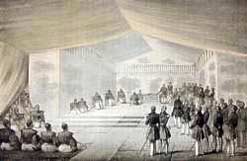 |
| Navy Commodore Matthew Perry |
Perry and his delegation presenting a letter
from the US President to the Japanese authorities |
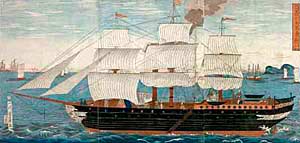 |
One of Perry's ships (Japanese
woodblock print) |
This year marks the 150th anniversary of the Kanagawa Treaty. Signed
on March 31, 1854, it is also known as the Treaty of Peace and Amity –
certainly a misnomer! The treaty, in fact, was a result of the gunboat
diplomacy of U.S. Navy Commodore Matthew Perry, whose flotilla of four
warships had threatened Edo (modern-day Tokyo), the shogun’s capital,
in the previous summer. The Kanagawa Treaty officially inaugurated diplomatic
relations between the United States and Japan, and marked the beginning
of the end of Tokugawa rule. Under the Tokugawa Shogunate, Japan had been
isolated from the rest of the world. As part of its isolationist policy,
the shogunate had banned the building of large oceangoing vessels to prevent
would-be insurgents from venturing overseas. As a result, Japan did not
have a navy. After the arrival of Perry, the small island nation was compelled
to develop a modern navy to preserve its sovereignty. Katsu Kaishu realized
this, just as he knew that modern technology would be essential to this
end. But Katsu was a nobody, the son of a petty samurai without an official
post. Fortunately for the future of Japan, however, he was also a shining
light of progressive thought – in a land ruled by a technologically
and politically backward regime. Katsu had submitted a letter to the shogun’s
government, in which he pointed out that Perry had been able to enter
Japanese waters unimpeded only because Japan did not have a navy to defend
itself. The shogunate must establish a navy, he professed. He advised
the shogunate to lift its ban on the construction of warships needed for
national defense; to manufacture Western-style cannon and rifles; to reform
the military according to modern Western standards; to establish military
academies. He was subsequently recruited into government service, and
received training at the new Naval Academy in Nagasaki.
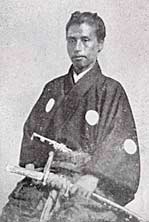 Katsu
Kaishu. He was a samurai, and founder of the Japanese Navy whose
protégé was Sakamoto Ryoma, a central player in the
overthrow of the Tokugawa Shogunate. Kaishu was a street-wise
statesman and outsider with interests in technology and modernization.
He was also an historian and prolific writer. In addition to Ryoma
he mentored many who became heroes of the Meiji Restoration (advent
of modern Japan). Katsu
Kaishu. He was a samurai, and founder of the Japanese Navy whose
protégé was Sakamoto Ryoma, a central player in the
overthrow of the Tokugawa Shogunate. Kaishu was a street-wise
statesman and outsider with interests in technology and modernization.
He was also an historian and prolific writer. In addition to Ryoma
he mentored many who became heroes of the Meiji Restoration (advent
of modern Japan).
|
One cold morning in early 1860 Captain Katsu was down with a fever.
He sat alone in his study at his home in Edo, his mind occupied with more
pressing matters than his immediate physical condition. “Rather
than die like a dog at home,” he would recall decades later, “I
thought that it would be better to die aboard a warship. The day had arrived
when we were to set sail, and not concerning myself with the throbbing
pain in my head, I told my wife that I would go… and have a look
at the ship,” so that his wife expected him to return soon. He would
not be back for four months.
 |
The Karin Maru. When Commodore
Perry with four black ships arrived off Uraga in this city in 1853,
the Tokugawa Shogunate (government of the shogun) realized the importance
of building up its own naval force after more than two centuries
of isolation. It soon requested the Dutch government to build the
warship Japan (250 tons), renamed Kanrin Maru (49 meters
in length, and heavily armed with 16 guns, cannons and a mortar
and howitzer. The cost was $70,000. Many of the Japanese associated
with this ship became public figures in Japan's modernization, including
Katsu Kaishu, Fukuzawa Yukichi, and Enomoto Takeaki. After the Japan-U.S.
Commerce and Trade Agreement was signed in 1858, the Kanrin
Maru, under the command of Kimura Settsunokami, sailed to San
Francisco as an escort vessel to the Japanese mission in the US.
The mission’s purpose was to exchange documents of the ratification
of the treaty in 1860. The Kanrin was the first Japanese
vessel to visit the US or any foreign country for centuries. |
 |
A Japanese woodblock print
depicting the stormy voyage of the Kanrin Maru in 1860. |
Not long after departing, the Kanrin Maru
ran into one of the worst typhoons ever encountered in the Pacific.
An American Officer, U.S. Navy Lieutenant John M. Brooke, and nine
other American sailors under his command, helped save the ship.
The Kanrin plodded ahead, and after 37 days at sea, she
finally dropped anchor in San Francisco harbor. The Japanese mission,
sailing aboard the US naval warship Powhatan, did not arrive
until twelve days later. On arriving in San Francisco Bay the Japanese
Admiral in charge of the ship made a handsome present in money to
each American. On board were also US Army officer Capt. Burke, a
civilian E.M. Keen. For a more detailed story on the passage of
the Kanrin Maru click
here.
|
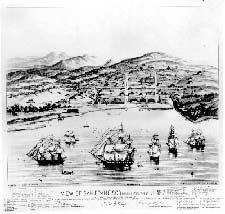 |
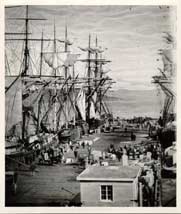 |
| How San Francisco Bay must have
looked to the visitors as they arrived in 1860. |
A view of a busy San Francisco wharf at Vallejo
Street in the early 1860's. The port was a major trading and immigration
center. |
|
Another image of San Francisco
in 1860 looking across the city toward the bay. |
On the morning of March 17, on her thirty-seventh day of passage, the
Kanrin Maru sailed through the Golden Gate of San Francisco, and became
the first Japanese vessel to reach the Western world. At her mainmast
and bows flew white banners emblazoned with the red Rising Sun. The local
San Francisco press made much ado about the arrival of the Japanese ship,
while Captain Katsu and his samurai crew reeled from culture shock. In
1860 San Francisco, with a population of 56,000, was the economic and
cultural center of the western United States. When the two-sworded, top-knotted
gentlemen from Japan dropped anchor off Vallejo Street Wharf shortly before
sundown, amidst an eclectic gathering of merchant ships flying flags of
every nation, their eyes were treated to a cosmopolitan feast which could
only have exceeded their wildest expectations. According to a local newspaper,
“the crew cast long and wistful eyes ashore at the city, whose strange
sights they were doubtless eager to explore.” Captain Katsu made
a grand impression on the San Franciscans, who discerned in him a likeness
to former explorer, Gold Rush millionaire, California senator, and recent
Democratic presidential candidate John Charles Fremont: “The Captain
of the corvette is a fine looking man, marvelously resembling in stature,
form and features Colonel Fremont, only that his eye is darker, and his
mouth less distinctly shows the pluck of its owner.”
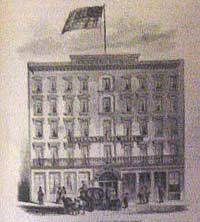 |
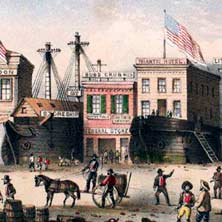 |
How San Francisco looked in 1860.
It was an amazing sight to the Japanese visitors. San Francisco
at the time was a thriving commercial town with exploding growth
following the California Gold Rush of 1849 and the 1850’s.
By ship and by wagon train a flood of treasure seekers from the
US and immigrants from Latin America, Europe, Australia and Asia
had swollen San Francisco. |
The International Hotel on Jackson
Street. Built in the mid-1850s, it was one of several new first
class hotels to spring up in San Francisco at this time when the
city was undergoing explosive growth. Located in the center part
of the city, the five-story hotel boasted elegant furnishings and
250 furnished rooms. Visitors could pay on a daily or weekly plan.
Boarders were provided meals from a restaurant on the premises.
The Japanese Samurai visitors probably housed there because the
hotel was convenient to the steam and sailing ship landings. |
Upon disembarking, the samurai entourage proceeded by carriage to the
International Hotel on Jackson Street. That Captain Katsu, unlike most
of his countrymen, had previously familiarized himself with Western customs,
dress and furnishings, and even cigars and champagne (although, as a rule,
he did not drink alcohol), is indicative of the elasticity of his very
open mind. That he did not blindly prescribe to standards of samurai dress,
but rather wore his thick black hair tied in a loose topknot, so that,
according to the local press, “he looked as if he knew nothing of
pomatum and gloried in its frizzled, shaggy look,” speaks loudly
of his outsider’s nature. That he did not seem to depend on an interpreter
because, while the others “did not understand all that was said
to them,” their captain was “acquainted with the language,”
speaks for his command of self-possession, because, in truth, Katsu did
not understand English either.
Captain Katsu had come to the United States resolved to introduce democratic
ideas and American technology into Japan. He did not, however, proclaim
this resolve to his less informed, and less enlightened, colleagues –
most of whom had inherited their privileged positions from their fathers,
and with whom he was constantly at odds, even as they sat in the exquisite
parlor of the International Hotel, exchanging niceties with Americans
whose government’s gunboat diplomacy had rent Japan asunder. Rather
he would save his resolve for great and kindred souls, namely Sakamoto
Ryoma and Saigo Takamori, who in less than eight years’ time would
overthrow the regime in whose service Katsu repeatedly risked his life.
Katsu’s resolve was bolstered by his farsightedness. He was a visionary
who was beginning even now to see the inevitability of his government’s
collapse – which was why, in just four years, when his house arrest
was imminent for harboring known revolutionaries, most notably Ryoma,
he would, as commissioner of the Tokugawa Navy, meet with Saigo, one of
the Tokugawa’s most formidable enemies. He would realize then that
the future of Japan no longer rested with the shogunate, but with a unified
and representative Japanese government. He would press upon Saigo the
absolute necessity for the warring samurai factions to unite if Japan
was to have a future at all. This, of course, was eventually what did
happen, with the overthrow of the Tokugawa Shogunate in 1868.
The samurai entourage savored their sojourn in the burgeoning silver
metropolis beside the Golden Gate. They walked the Victorian streets.
They entered a photographic studio on Montgomery Street. They toured the
waterfront near the Vallejo Street Wharf, viewing with keen interest a
merchant ship from Panama. Captain Katsu visited the San Francisco Baths
on Washington Street, because he “was desirous of trying the American
style” of bathing. He road the sand cars on the Market Street Railway,
and observed local factories. (Years later Katsu expressed his disbelief
at the spectacle of a factory worker openly engaged with a prostitute
during break time, and his perplexity at being offered “the wife
of Mr. So-and-So for a certain amount per hour.”) Captain Katsu
explored the shops in town, his interest particularly aroused by Keith’s
Apothecary, because on the previous day one of his sailors had died of
illness. He went to the marble yard on Pine Street to order a gravestone,
on which he wrote an epitaph for the burial which took place in the grounds
of the Marine Hospital. The samurai noted his repulsion at the sight of
large pieces of beef and pork at the front of a butcher shop, “covering
my nose as I passed by.”
One evening Captain Katsu was invited to a dance party at the San Francisco
home of a United States Navy officer. The samurai was impressed by the
“courtesy of everyone,” and wondered at the strange customs
of the Americans. “The men put their arms around their wives’
shoulders and waists to dance… [One man] took the hand of another
man’s wife to dance.” From the eyes of a man born and bred
amidst the mores of feudal Japan, even one as well-versed in things Western
as Katsu Kaishu, the dance party was certainly a strange spectacle. A
man of the samurai class simply did not bring his wife to a social gathering.
It would have been a gross violation of protocol. He would no sooner do
so than he would leave home without his swords, forsake liege lord or
clan, or relinquish his warrior status. The notion, in fact, never crossed
his mind. Whether or not Captain Katsu danced with the wives of his American
hosts, he particularly enjoyed the ice cream they offered. “And
the champagne, served with crushed ice, was most delicious. People in
Japan have never tasted anything like it.” After a stay of nearly
two months in San Francisco, the Kanrin Maru set sail on May 8, returning
safely to Japan soon after.
On a bluff in overlooking the Golden Gate in lush Lincoln Park in the
northwestern extremity of San Francisco, stands a stone monument to the
Kanrin Maru. Dedicated in 1960, it was a gift from the city of Osaka to
commemorate the 100th year since of the Japanese ship’s historic
voyage. As mentioned above, this year marks the 150th anniversary of the
Kanagawa Treaty. Both this monument and this anniversary must also celebrate
the life and times of the ship’s captain, who rose to become one
of the greatest men in Japanese history.
Acknowledgements:
Permission to use the photo of Katsu Kaishu by FightingArts.com was
provided by Takaaki Ishiguro, a photo collector currently living Tokyo.
Harbor views of San Francisco provided courtesy of www.BoatingSF.com.
The S.F. street scene was a cropped enlargement of this image.
Photo of the Japanese mission members was declared as to be in the
public record by the Japanese government.
The image of Perry and his delegation presenting a letter from the
US President to the Japanese authorities provided complements of Kauai
Fine Arts located in Lawai, Hawaii.
S.F. Warf photo from 1860 provided with permission of the S.F. Historical
Center, S. F. Public Library.
Drawing of the International Hotel in San Francisco from the book “Annals
of San Francisco” by Frank Soule, John H. Gibon M.D. and James
Misbet published by D. Appeton & Co. 1885, Copyright 1884, p. 650.
About The Author:
Romulus Hillsborough is an acclaimed writer and teacher of Japanese History.
His books include RYOMA - Life of a Renaissance Samurai (Ridgeback Press,
1999), Samurai Sketches: From the Bloody Final Years of the Shogun (Ridgeback
Press, 2001), and Shinsengumi: The Shogun’s Last Samurai Corps (Tuttle
2005). Hillsborough has been a regular contributor to FightingArts.com. |